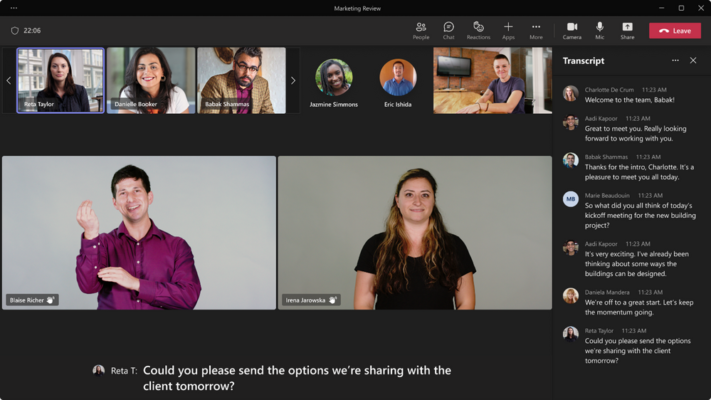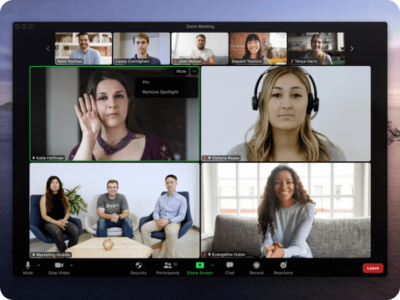
On August 7, 2023, the United States Federal Communications Commission (FCC) officially published a proposed rule designed to improve the accessibility of video conferencing and video conferencing platforms for people with disabilities.
The FCC is seeking public comment on the proposed Access to Video Conferencing rule. Comments can be submitted until September 6, 2023. The public will have the opportunity to reply to other people’s comments until October 6, 2023.
Read the proposed video conferencing accessibility rule here.
There is a button on the proposed rule linked above labeled “submit a formal comment.” However, as of today (August 7) selecting that button brings up a message that says “submitting a formal comment directly via the federal register is not available for this document at this time.” Instead, the message directs visitors to Further information about submitting comments is available on the FCC website.
Comments can also be filed (more easily) through the FCC’s “Submit an Express Comment Form.” On both FCC forms you will need to enter the Proceeding Number, which is 23-161. I encourage the FCC to make this process easier in the future!
Comments need not be “formal” or involve a lawyer. Disabled people are encouraged to share personal experiences with accessibility barriers when using video conferencing — at school, in healthcare settings, and everywhere else.
It is important to remember that the CVAA already requires the accessibility of video conferencing. The new proposed rule is designed to improve accessibility by identifying specific “performance objectives” that will strengthen existing requirements.
Think of performance objectives as specific things video conferencing platforms need to do to be accessible and usable. If you have experienced particular accessibility problems during a video conference, or have ideas for what video conferencing platforms should be required to do to fix those problems, that is something that should be included in your comments.
It is also important to remember that other disability rights laws, including the Americans with Disabilities Act, also have provisions impacting the accessibility of video conferencing. See, for example, my July 2023 article on this website titled Offering Healthcare? The ADA and the Affordable Care Act Mean Accessible Telehealth, #HealthTech, and Content.
Jump to
What kinds of comments is the FCC hoping to receive?
In the Access to Video Conferencing proposed rule, the FCC seeks comments on specific things. The public, however, is not limited by what the FCC has specifically asked about.
Imagine a world with no barriers for disabled people to fully participate in video conferencing. At its core, that is what comments can and should be about.
Some of the specific things the FCC asks about are as follows. Please note that this is not a complete list and this article is not a full analysis of the proposed rule. Readers are encouraged to read the complete proposed rule, portions of which were first presented in a report authored by the FCC’s Disability Advisory Committee.
Comments the FCC has specifically asked for include:
- Should the FCC amend existing rules to define more specific objectives for making video conferencing accessible?
- Are current accessibility features on conferencing platforms like Zoom, Teams, or Google Meet effective? If not, how could they be improved?
- Are current accessibility features always available when needed? Are they easy to use? What improvements would you like to see? What new features would improve accessibility?
- Are automated captions effective? (Specific examples of any problems with automated captions would be good to include in comments.)
- What rules are needed to best ensure accurate captions that are delivered at the same time (synchronous) as spoken words?
- What rules are needed to ensure effective communication for people who rely on sign language and text-to-speech?
- Are the proposed performance objectives sufficient to ensure that blind and deafblind users can operate all controls and independently participate in video meetings?
- Should the updated rules allow participants to turn off their screens during video conferencing? This topic is addressed in a section of the proposal titled “Privacy screen rule.”
- The proposed rule discusses how Telecommunications Relay Services (TRS) and its federal funding integrates with video conferencing and seeks comments on this aspect of the proposal. The discussion of TRS in the FCC proposal starts here.
Please remember that I am not an expert in the CVAA, TRS, or the technical requirement regarding the accessibility of video conferencing. I look forward to reading articles and suggested comments about the proposed rule from those who are.
I will update this post with links to comments shared by disability rights organizations and disabled people impacted by this proposed rule. Please use the contact form on this website to send links to that information.
Back to topFCC Actions in June 2023 about the proposed Access to video conferencing rule
The FCC rulemaking process is complicated! And different from the Department of Justice rulemaking process I am most familiar with. (Shout out to Blake E. Reid, law professor at Colorado Law for helping me with the FCC intricacies.)
I first learned of the FCC’s efforts to improve video conference accessibility in June when the Commission issued a press release and other documents about this important aspect of 21st century digital inclusion.
That month, the FCC began the process leading to new and stronger rules on the accessibility of video conferencing platforms for people with disabilities described above. These rules, when (and if) adopted, will strengthen a law called the Twenty-First Century Communications and Video Accessibility Act (CVAA). (There is also an unrelated legislative effort to strengthen the CVAA as described below.)
What is the CVAA and the FCC?
In the United States, the Federal Communications Commission is responsible for implementing and enforcing a law called the Twenty-First Century Communications and Video Accessibility Act (CVAA).
That law, passed in 2010, is officially described as “An act to increase the access of persons with disabilities to modern communications.” The Commission is directed by five commissioners who are appointed by the President of the United States and confirmed by the U.S. Senate.
In its June 2023 actions the Commission took important steps to ensure that the CVAA stays current with “modern communications.”
As one of the Commissioners stated at its June 8th meeting:
From Zoom parent-teacher conferences, to WebEx telehealth calls, to Teams work meetings, web-based video conferencing is now one of the primary ways we communicate, in both our personal and professional lives. So we must make sure that video conferencing is accessible to everyone. June 8 Statement of Commissioner Geoffrey Starks
Proposed Update to the CVAA
While the FCC is engaged in the Access to Video Conference rulemaking discussed above, an independent effort is underway to improve the FCC. A bill has been introduced in the United States Congress that would update and strengthen the CVAA by creating new legislation titled the Communications, Video, and Technology Accessibility (CVTA) Act.
This legislation was first introduced in November 2022 and reintroduced on the eve of the 33rd anniversary of the ADA last month. It is proposed, and not yet a law in the United States.
- Read the July 25, 2023 press release announcing reintroduction of the CVTA
- Read the proposed CVTA legislation that would update the CVAA if passed.
The fate of this proposed legislation does not impact the rulemaking about access to video conferencing.

What did the FCC say in June about video conference accessibility?
The bottom line of the FCC’s June 2023 actions is two-fold. Links to all relevant documents are in the Resource section below for those who want to learn more.
- First, the Commission confirmed that existing regulations that require accessibility of “advanced communications systems” apply to commonly used video conferencing services like Teams, Zoom, and Google Meet. According to the FCC, this part of the June actions “resolves a long-standing legal question about whether the types of platforms we all use for work, play, education, citizenship, healthcare and more, are already required to be accessible under existing rules.” The FCC said they did.
- Second, the Commission decided to start the process to make new regulations that will include “Performance Objectives” that are more specific than the general accessibility requirements that now exist.
On June 8 the FCC also began the process of making new rules that will govern the quality of accessibility features in video conferencing platforms. As described by the Commission. The FCC plans to amend existing rules to:
add specific performance objectives for enhancing the accessibility of interoperable video conferencing services, including: speech-to-text (captioning) capabilities; text-to-speech capabilities; and enabling the use of visual language interpreting (describing slides). FCC June 8 announcement
The rule-making process for the federal government in the United States typically starts with a Notice of Proposed Rule Making (NPRM). The FCC’s June 8 Order was published as an NPRM on August 7. In its June 8 announcement the FCC also announced it would seek public comment on integrating the US Telecommunications Relay Service (TRS) with video conferencing services without requiring a dial-up telephone call.
The last issue addressed in the FCC’s June 8 materials concerns a current rule that people using the US Video Relay Service are not allowed to turn off their cameras while using the service. On June 8 the FCC waived “waives for providers for one year, subject to conditions, a rule that restricts VRS users’ ability to turn off their video cameras when not actively participating in a video conference.”
Learn More about the FCC’s June 2023 video conference actions leading to the proposed rule
For those who want to dive deeper into the FCC’s actions, here are links to the official documents where you can learn more:
- The FCC June 12 announcement is titled “FCC Requires Access to Video Conferencing, Proposes Performance Objectives and TRS Integration” It sets out the basics of the FCC’s actions.
- FCC’s unofficial publication of the Notice of Proposed Rulemaking for more specific accessibility requirements. This document is a 62 page PDF(!) Pages 42-68 contain the Notice of Proposed Rulemaking “to improve the accessibility of video conferencing.” These pages include proposed performance objectives and information about a “safe harbor” for technical standards.”Pages 1 – 27 include background information about the NPRM, including a section titled “Growth of Video Conferencing” and “Accessibility Concerns”
- On June 8, 2023, the FCC added a page to its website titled FCC Requires Video Conferencing Accessibility & Proposes ASL Support. On this page are links to Word, PDF, and text versions of three documents related to the announcement
- June 8 Press Release from the FCC titled FCC Requires Video Conferencing Platforms To Be Accessible And Proposes Platform Integration With Sign-Language Services. At the end of the press release are the words: “This is an unofficial announcement of Commission action. Release of the full text of a Commission order constitutes official action.” This happened on July 12.
- Statement of Chairwoman Jessica Rosenworcdel at the June 8 meeting. In this statement she thanks disability rights groups, saying “we are blessed to have their interest and assistance in this effort. The Commission chairperson also notes that the
FCC’s actions around video conferencing accessibility is aligned with the fundamental idea behind the CVAA —that when technology changes our accessibility policies need to evolve and keep paceFCC Chairwoman Rosenworcdel
- Statement Of Commissioner Geoffrey Starks at the June 8 meeting.